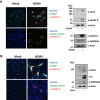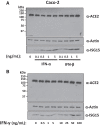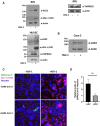Human Cytomegalovirus Infection of Epithelial Cells Increases SARS-CoV-2 Superinfection by Upregulating the ACE2 Receptor
- PMID: 36408607
- PMCID: PMC9927080
- DOI: 10.1093/infdis/jiac452
Human Cytomegalovirus Infection of Epithelial Cells Increases SARS-CoV-2 Superinfection by Upregulating the ACE2 Receptor
Abstract
Severe acute respiratory syndrome coronavirus 2 (SARS-CoV-2), the causative agent of coronavirus disease 2019 (COVID-19), has caused widespread morbidity and mortality since its onset in late 2019. Here, we demonstrate that prior infection with human cytomegalovirus (HCMV) substantially increases infection with SARS-CoV-2 in vitro. HCMV is a common herpesvirus carried by 40%-100% of the population, which can reactivate in the lung under inflammatory conditions, such as those resulting from SARS-CoV-2 infection. We show in both endothelial and epithelial cell types that HCMV infection upregulates ACE2, the SARS-CoV-2 cell entry receptor. These observations suggest that HCMV reactivation events in the lung of healthy HCMV carriers could exacerbate SARS-CoV-2 infection and subsequent COVID-19 symptoms. This effect could contribute to the disparity of disease severity seen in ethnic minorities and those with lower socioeconomic status, due to their higher CMV seroprevalence. Our results warrant further clinical investigation as to whether HCMV infection influences the pathogenesis of SARS-CoV-2.
Keywords: ACE2; COVID-19; HCMV; SARS-CoV-2; coinfection; human cytomegalovirus.
© The Author(s) 2022. Published by Oxford University Press on behalf of Infectious Diseases Society of America.
Conflict of interest statement
Potential conflicts of interest. All authors: No reported conflicts of interest. All authors have submitted the ICMJE Form for Disclosure of Potential Conflicts of Interest. Conflicts that the editors consider relevant to the content of the manuscript have been disclosed.
Figures







References
-
- Berlin DA, Gulick RM, Martinez FJ. Severe COVID-19. N Engl J Med 2020; 383:2451–60. - PubMed
Publication types
MeSH terms
Substances
Grants and funding
LinkOut - more resources
Full Text Sources
Medical
Miscellaneous

